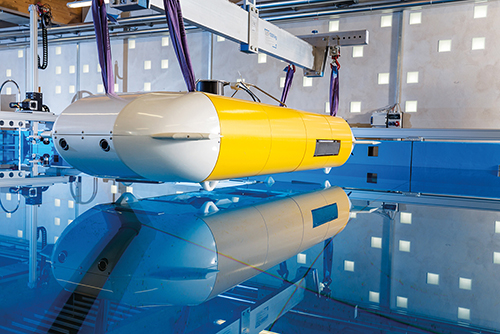They chose an open architecture where water flows through much of the structure. A very light shell made of syntactic foams provides buoyancy. Electronic components, impervious to pressure, are cast in watertight silicone resin. The researchers also drew on the institute’s expertise in the areas of underwater sensors, sensor data fusion, environmental sensing, autonomous navigation and remotely operated underwater vehicles.
Their efforts culminated in DEDAVE, short for Deep Diving AUV for Exploration (see photo). Presented to the public in 2016, it is pictured here hovering above the Fraunhofer IOSB-AST test pool. Kraken Sonar, Inc., a Canadian company, licensed DEDAVE and deployed it in 2017 to find several test models of a hypersonic interceptor aircraft called the Avro Canada CF-105 Arrow at the bottom of Lake Ontario. Canada stopped this aircraft’s development in the 1950s for strategic reasons. All documents and components were destroyed. There is now a great interest in reconstructing the details of this historic project. The models’ discovery attracted enormous attention and buzz in the media, particularly in North America.
Fraunhofer IOSB also took up the challenge of the Shell Ocean Discovery XPRIZE, a global technology competition launched in December 2015. The competition’s goal was to
invent highly autonomous yet affordable new technologies to map the ocean floor in great detail and to demonstrate their ability to do this. The ARGGONAUTS team from Fraunhofer IOSB developed tandems comprising lightweight autonomous surface vehicles and a swarm of torpedo-shaped diving drones. The only German entry among 32 competing teams, the ARGGONAUTS were one of the best five finishers.
More information
Deep Diving AUV for Exploration (DEDAVE)
Press release from 3.6.2019 »Shell Ocean Discovery XPRIZE: ARGGONAUTS unter besten fünf Teams«
 Fraunhofer Institute of Optronics, System Technologies and Image Exploitation IOSB
Fraunhofer Institute of Optronics, System Technologies and Image Exploitation IOSB 